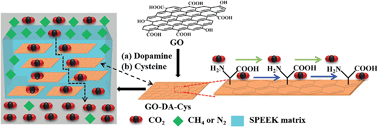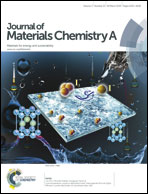Enhancing the CO2 separation performance of composite membranes by the incorporation of amino acid-functionalized graphene oxide†
Abstract
Composite membranes are fabricated by incorporating amino acid-functionalized graphene oxide (GO-DA-Cys) nanosheets into a sulfonated poly(ether ether ketone) (SPEEK) polymer matrix. Graphene oxide (GO) nanosheets are functionalized with amino acids through a facile two-step method using dopamine (DA) and cysteine (Cys) in succession. The CO2 separation performance of the as-prepared membranes is evaluated for CO2/CH4 and CO2/N2 systems. GO nanosheets increase more tortuous paths for larger molecules, enhancing the diffusivity selectivity. Amino acids with carboxylic acid and primary amine groups simultaneously enhance the solubility selectivity and reactivity selectivity. Accordingly, CO2 molecules can transport quickly due to the enhanced selectivity. The optimum separation performance is achieved at the GO-DA-Cys content of 8 wt% with selectivities of 82 and 115 for CO2/CH4 and CO2/N2, respectively, and a CO2 permeability of 1247 Barrer, significantly surpassing the Robeson upper bound reported in 2008. Besides, the mechanical and thermal stabilities of the composite membranes are also improved compared with the pristine SPEEK membrane.


 Please wait while we load your content...
Please wait while we load your content...